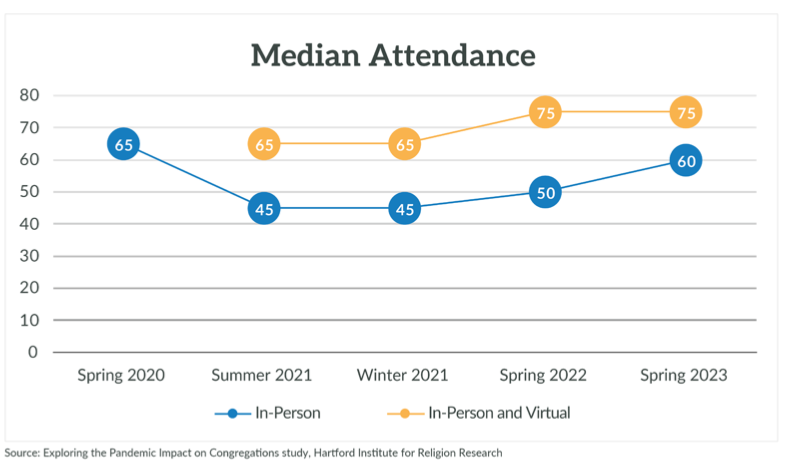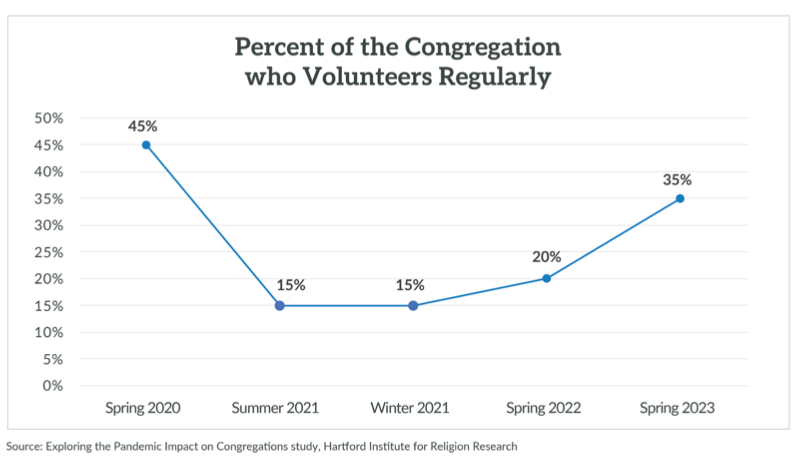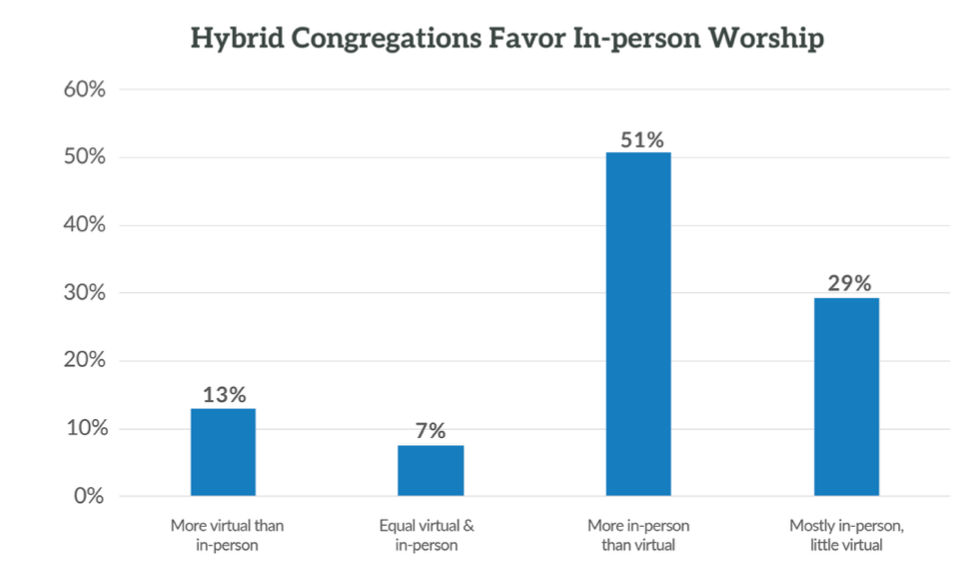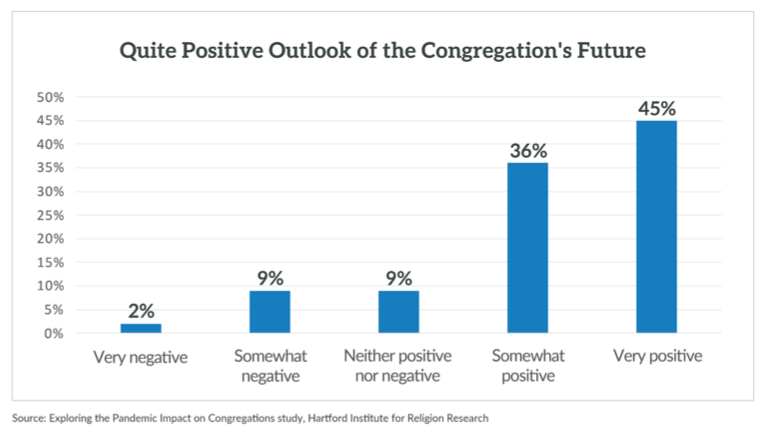Increases in attendance, giving and participation, and a decline in internal squabbling, may signal America’s churches are emerging from the dark days of the COVID-19 pandemic and its aftermath, new research shows.
But the study — “Back to Normal? The Mixed Messages of Congregational Recovery Coming Out of the Pandemic” — also found Mainline, evangelical, Black and multiracial churches in the United States are not out of the woods yet when it comes to the lingering consequences of the coronavirus outbreak.
“Clearly, there are indications of positive dynamics for Christian churches — attendance is rebounding, income is up, volunteering is on the rise, and conflict has diminished. These are all indications that commitment levels are climbing within the congregation and new people are engaging with the churches either in person or virtually,” according to the report released Sept. 4 by the Hartford Institute for Religion Research at Hartford International University for Religion and Peace.

But those gains are being experienced unequally across the landscape of churches, the study added. “Many report attendance below where it was prior to the pandemic. The average size of the in-person attendance is a median of 60. Most congregations are still suffering from a lack of participation by younger generations, with aging clergy and growing percentages of older members. Additionally, at a time when churches need to continue to adapt and innovate, the data indicate that a greater percentage of congregations are less willing to change.”
The data derive in part from a larger project titled “Exploring the Pandemic Impact on Congregations: Innovation Amidst and Beyond COVID-19,” which included a sampling of 4,809 churches across 58 denominational organizations in January to May 2023. A 2021 survey and two from last year also were included in order to track responses over time.
“The analysis also includes data from the 2020 Faith Communities Today survey, which included multifaith responses from 15,278 congregations, presenting a pre-lockdown baseline. However, only the Christian responses from FACT 2020 are used in this report for consistency of results,” researchers explained.
“Churches have not arrived at a place of stasis and normalcy, no matter what members wish for.”
Researchers set out to track the changes churches underwent as they rebounded from pandemic-induced loss, disruption and trauma. “What is abundantly clear from these latest results is that the societal and religious alterations of the post-pandemic reality are still in flux; the unsettledness is still with us. Churches have not arrived at a place of stasis and normalcy, no matter what members wish for.”
A positive trend uncovered in the study is that attendance is rising — depending on how attendance is measured.
“In-person worship attendance is generally still below pre-pandemic levels. Looking at in-person figures only, the Faith Communities Today 2020 pre-pandemic worship attendance showed a median of 65 people, whereas the 2023 survey had a median of 60 attendees. However, taking into account virtual attendance combined with in-person numbers, total worship attendance shows a median of 75, which is 15% above pre-pandemic worship figures.”

Overall, attendance is 9% below pre-pandemic worship figures, the study found. “But, attendance patterns vary widely across the surveyed congregations. In over 50% of churches, combined worship attendance (both in person and virtual) is down considerably, but 33% of churches are now above where they were pre-pandemic. Additionally, 16% of current attendees are new to the congregation since 2020 — this follows a decades-long pattern that showed an increase of, on average, about 5% of new attenders each year.”
Median church income also has risen during the past three years, from $120,000 in 2020 to $170,000 in 2023, a 42% increase that matches national giving trends documented in this year’s Giving USA report.
“The more a church emphasized online and electronic giving, the greater their per capita giving rose.”
The Hartford report surmises this rise may be attributable to the increased embrace of virtual giving among U.S. churches, up from 20% of congregations in 2019 to 67% today. Earlier studies “found that the more a church emphasized online and electronic giving, the greater their per capita giving rose. This is also true with the 2023 survey.”
The survey also found “a significant recovery of the percent of volunteers over the past year to an average of 35% of regular participants. This percentage is now much closer to the pre-pandemic level of 40%.”

Hartford researchers also acknowledged surprise at finding lower levels of internal church conflict given the tense political and social climate in the U.S.
“One possible implication of these seemingly counterintuitive findings might be that people in contention with their existing church might have left prior to, or early in, the pandemic. Therefore, the result might be that the last three years have created congregations with attenders that are more homogeneous and of one mind which leads to less serious moments of conflict.”
Most churches throughout the pandemic responded by embracing hybrid worship services, the report says. “This dramatic alteration has the potential to reform a static place and time-based physical worshipping community into a congregation beyond the walls with the potential for revolutionary adaptation.”
The movement is widespread, the report explains. “The recent data suggests that nearly three-quarters of churches have adopted this model, and that percentage seems to be stabilizing. A very small percentage of churches (2%) are entirely online but 73% offer both in person and virtual worship. This is an astonishing change in a very short time given that only 20% of these churches said they offered online streaming worship in 2019.”

The upward movement in attendance, giving and volunteerism in some congregations also reflects increasing commitment levels and, in turn, an indication of congregational recovery, researchers said. “Combining these trends with a steady influx of new participants at roughly 5% a year may suggest that while churches have lost former members, those who remained, alongside recent arrivals, seem to be rising to the occasion and filling in the gaps with a greater sense of commitment.”
Church leaders expressed optimism about their futures in the study. “In total, over 80% of congregations surveyed expressed a positive outlook on their future, with almost half (44%) expressing a very positive view.”
Researchers speculated about the factors driving that confidence: “Perhaps this is optimism born out of surviving through the pandemic, or wishful thinking, or even indication of a social desirability bias around this question implying that no leader wants to verbalize that their church has little hope for the future.”

But other data suggest “all is not entirely rosy” for the U.S. church, the report explains. These challenges include systemic patterns of membership decline, aging membership and clergy, and waning interest from young people. “Likewise, the pandemic might well have intensified these pressures for some churches, especially those who were already struggling to survive. It must also be remembered that this survey measures only those churches still in existence, not those which may have already closed or merged.”
The survey found “the basic growth and decline profile across the religious landscape hasn’t greatly changed and if anything, has slightly worsened in three years. Essentially, the pre-pandemic and current patterns are nearly identical. One-third of the 4,809 churches indicate they have grown in attendance since 2020, while just over 50% report a slight or severe decline from where they were pre-pandemic. This latest survey shows a slight increase of 3% for churches in the ‘much decline’ category (those showing a decline of more than 25% from their pre-pandemic attendance) with corresponding declines in a few of the other categories.”

Among the key pre-pandemic realities that continue to challenge churches are aging ministers and an increasing number of members who are 65 and older, the study finds. “In 2020, the average senior leader age was 57 years old, and the typical church had 33% of attenders over 65 years of age. While not a highly dramatic rise, the 2021 and 2023 surveys show these trends continuing. The average age of clergy has increased by one year at each of these survey points. Likewise, the percentage of attenders over the age of 65 continues to increase from 33% in 2020 to 36% in 2023.”
Disturbingly, researchers reported a decline in the “willingness to change to meet new challenges” among congregations in 2023.
“Their earlier flexibility and creativity in response to the pandemic is beginning to diminish.”
“This is especially troubling because this measure indicated a greater inclination in 2021 post-pandemic churches to do what was necessary to adapt compared to pre-pandemic responses, with nearly 50% strongly agreeing to that attitude,” the report says. “But by 2023, both the total congregations in agreement and those strongly in agreement had dropped significantly and are now below where they were in early 2020. Obviously, congregational dynamics and worship patterns have changed in many churches in the past three years, but this finding seems to indicate that their earlier flexibility and creativity in response to the pandemic is beginning to diminish.”

Another disturbing pattern spotted in the survey is that of clergy exhaustion exacerbated by the rise of technology, hybrid worship and having to continually adapt in a post-pandemic setting.
“This comes at a time when the loss of members is still being felt and the level of volunteering while growing is still less than in the past,” researchers summarize. “The inertia of fatigue and three years of survival are taking their toll on clergy. Survey results point to evidence that many faith leaders are exhausted and disillusioned. They are increasingly entertaining thoughts of leaving the ministry, though fewer often think about quitting, leaving their current placement, or doubting their overall call to ministry.”
When polled in 2021, 37% of ministers said they had not seriously considered leaving their churches. “In 2023, the percent of clergy entertaining this thought at all has grown to over half of clergy (51%). This increase is quite concerning and should be considered a serious warning sign. While relatively few of these clergy dwell on this thought often, over a quarter have considered it more than once or twice in moments of stress.”
“This increase is quite concerning and should be considered a serious warning sign.”
The most likely to leave are younger ministers, women, part-time and bivocational ministers, those who consider themselves and their church a bad fit, and those who have been recently hired, the survey says. “Those clergy in congregations that are financially challenged, less willing to change, have a negative outlook on the future, and have higher conflict are more likely to consider leaving the ministry.”
The study also found mixed messages when asking clergy about resiliency. “Only 15% have doubted a few times or more since 2020 that they are called by God to ministry. Likewise, clergy indicate their mental, spiritual and relational health is quite strong, scoring an 8.1 out of 10-point rating scale, while their physical and financial averages slightly lower at 7.5 and 7.4 respectively.”
Yet, clergy also reported high levels of hopefulness about the future of the church. The report finds 80% are somewhat or very positive and only 11% are somewhat or very negative. “While showing warnings signs of stress and fatigue among the clergy, the present data does not indicate they have given up hope and while discontented at times, ministers still seem resilient, healthy, and generally hopeful.”


